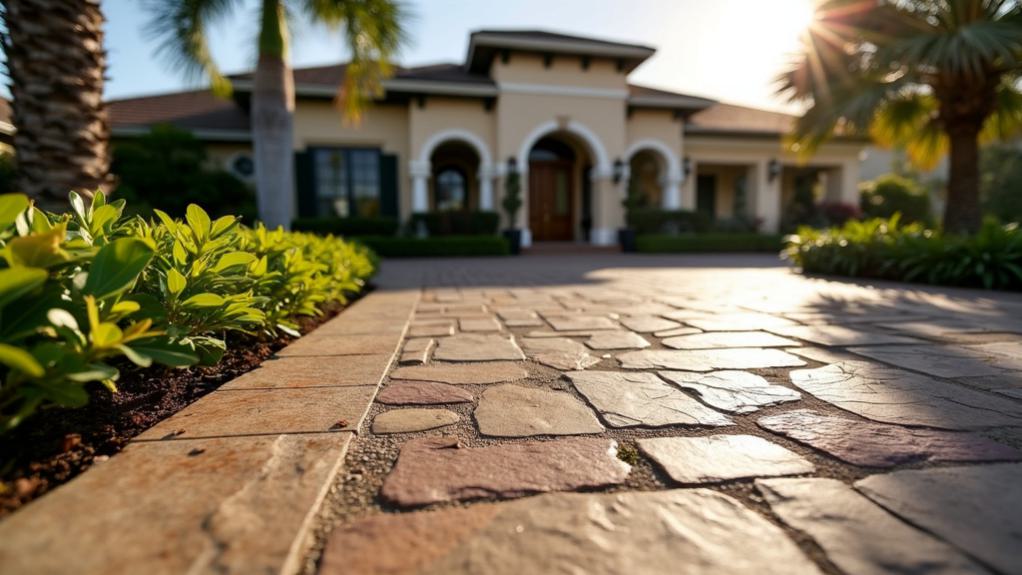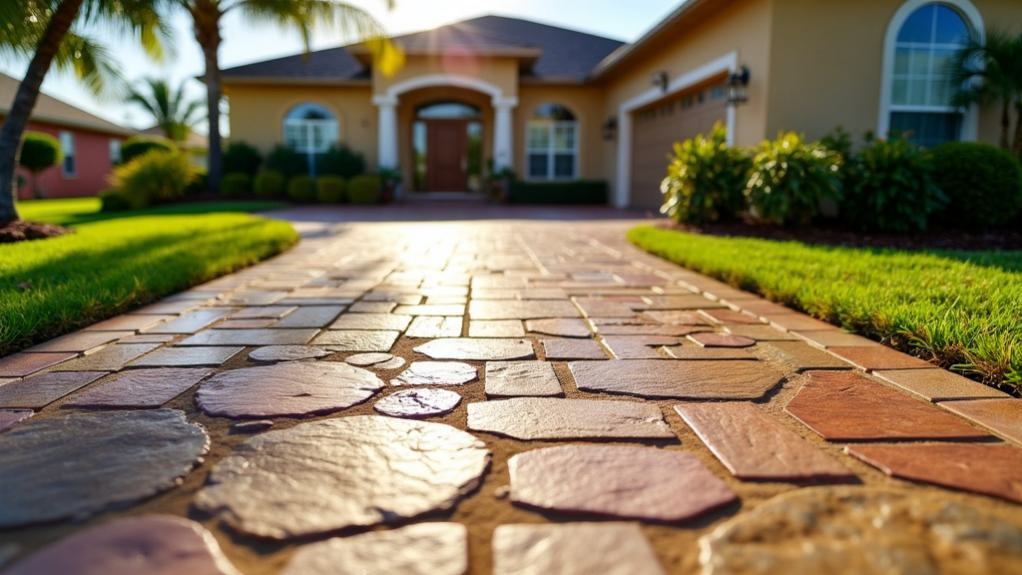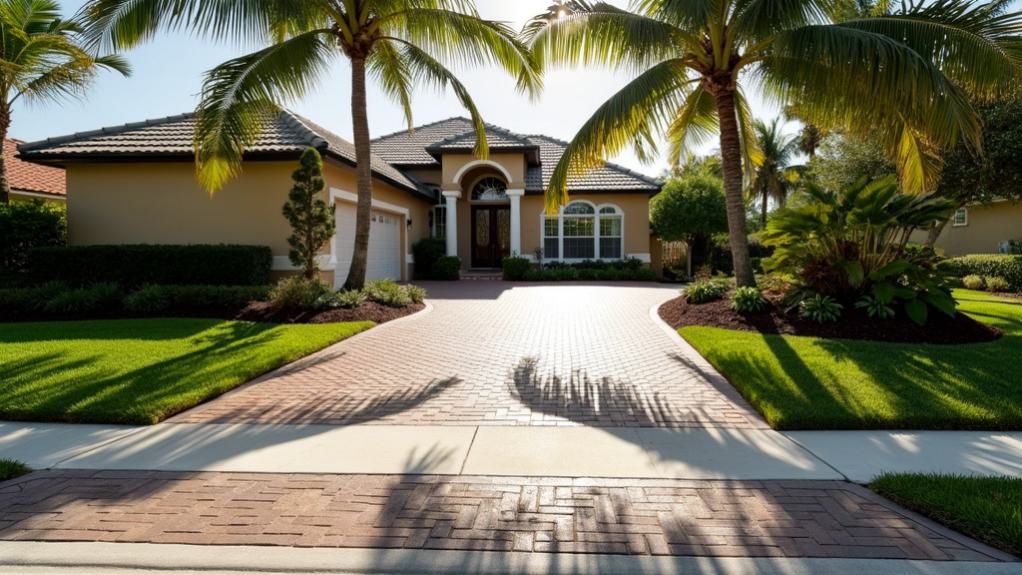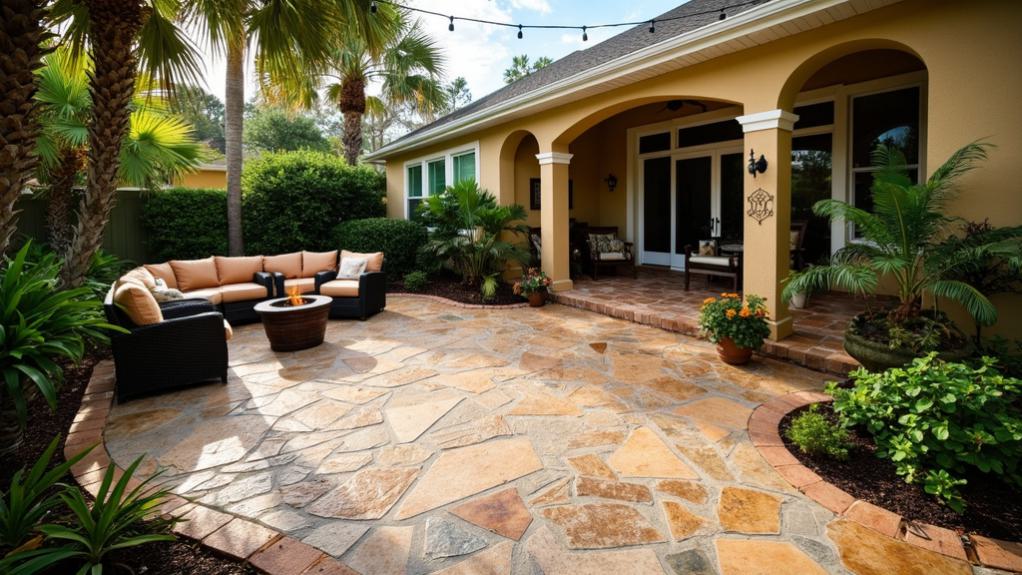Stamped concrete offers Florida homeowners a durable and versatile solution for enhancing curb appeal. It withstands the state's harsh climate while providing design flexibility to mimic materials like brick, stone, or tile. Popular patterns include beach-inspired designs, tropical motifs, and classic textures. The wide range of color options allows for customization to complement existing architecture. Stamped concrete is cost-effective compared to natural stone or pavers, with faster installation and lower long-term maintenance costs. It's ideal for patios, pool decks, driveways, and walkways, significantly improving outdoor living spaces. Proper maintenance ensures longevity, with regular sealing protecting against UV damage and wear. Understanding the installation process and comparing materials can lead to informed decisions for your home improvement project.
Benefits of Stamped Concrete

Stamped concrete offers five key benefits for Florida homeowners.
First, it provides exceptional durability, withstanding the state's intense heat, humidity, and occasional severe weather. This resilience translates to lower maintenance costs and longer-lasting outdoor surfaces.
Second, stamped concrete boasts superior design flexibility, allowing homeowners to mimic the appearance of more expensive materials like brick, stone, or tile at a fraction of the cost. The wide range of patterns and texture variety available ensures a customized look that complements any architectural style.
Third, stamped concrete is highly versatile, suitable for patios, pool decks, driveways, and walkways. Its seamless integration with existing landscaping enhances overall property aesthetics.
Fourth, the material offers excellent slip resistance when properly treated, improving safety around wet areas like pools.
Finally, stamped concrete is cost-effective compared to natural stone or pavers, providing a high-end look without the premium price tag. Installation is typically faster than laying individual stones, reducing labor costs.
These benefits make stamped concrete an attractive option for Florida homeowners seeking to enhance their property's curb appeal and functionality.
Popular Patterns for Florida Homes
Given the design flexibility of stamped concrete, Florida homeowners have numerous pattern options to choose from. Popular patterns often reflect the state's coastal environment and tropical atmosphere. Beach-inspired designs, such as seashell or sand dollar imprints, are particularly favored for pool decks and patios.
Tropical motifs, including palm fronds or hibiscus flowers, can add a touch of paradise to outdoor living spaces.
For a more traditional look, many Florida homeowners opt for patterns that mimic natural stone or brick. These include:
- Ashlar slate, which replicates the appearance of cut and fitted stone
- Herringbone brick, offering a classic and timeless aesthetic
- Cobblestone, providing a rustic, Old World charm
- Flagstone, creating a natural, organic look
The choice of pattern should complement the home's architectural style and surrounding landscape.
When selecting a stamped concrete pattern, consider factors such as the area's intended use, maintenance requirements, and color palette. Properly chosen and executed, stamped concrete patterns can significantly enhance the curb appeal and overall value of Florida homes while providing a durable, low-maintenance surface for years to come.
Color Options and Customization

A myriad of color options await Florida homeowners when choosing stamped concrete for their properties. The versatility of stamped concrete allows for a wide range of color palettes, from earth tones that complement the natural Florida landscape to vibrant hues that make a bold statement.
Integral color admixtures can be added to the concrete mix, ensuring consistent coloration throughout the material. Alternatively, surface-applied color hardeners offer a more concentrated pigment on the concrete's surface.
Custom designs are achievable through the strategic use of multiple colors within a single project. This technique can create visual interest, define specific areas, or mimic the appearance of more expensive materials like natural stone or brick.
Color release agents, applied before stamping, add depth and dimension to the finished surface by highlighting the pattern's texture.
For a truly personalized touch, homeowners can opt for custom stenciling or saw-cut designs. These methods allow for the incorporation of unique motifs, logos, or patterns that reflect individual tastes or complement existing architectural elements.
When selecting colors, it's crucial to consider factors such as sun exposure, surrounding landscape, and the home's exterior color scheme to ensure a cohesive and long-lasting result.
Maintenance and Durability
Stamped concrete's durability and maintenance requirements are crucial considerations for Florida homeowners.
Proper cleaning and sealing techniques, including pressure washing and applying high-quality sealants, are essential to preserve the concrete's appearance and structural integrity.
The material's weather resistance properties and long-term cost effectiveness make it an attractive option for outdoor spaces in Florida's challenging climate.
Cleaning and Sealing Techniques
Regularly maintaining stamped concrete is crucial for preserving its appearance and longevity in Florida's harsh climate. Proper cleaning and sealing techniques are essential components of this maintenance routine.
To clean stamped concrete effectively, use pH-neutral cleaning products specifically designed for decorative concrete surfaces. Avoid harsh chemicals or abrasive tools that may damage the surface texture or color.
Sealing techniques play a vital role in protecting stamped concrete from UV rays, moisture, and stains. Apply a high-quality, penetrating sealer every 2-3 years, or as recommended by the manufacturer.
When selecting a sealer, consider:
- UV resistance for Florida's intense sunlight
- Breathability to prevent moisture entrapment
- Slip resistance for safety, especially around pools
- Compatibility with the existing concrete finish
To apply the sealer, ensure the surface is clean and dry. Use a low-pressure sprayer or roller for even application, following the manufacturer's instructions for coverage and drying times.
In high-traffic areas or regions prone to frequent rain, consider applying an additional coat for enhanced protection. Regular inspection and prompt resealing when necessary will help maintain the stamped concrete's aesthetics and structural integrity in Florida's challenging environment.
Weather Resistance Properties
While proper cleaning and sealing techniques form the foundation of stamped concrete maintenance, understanding its weather resistance properties is key to ensuring long-term durability in Florida's climate.
Stamped concrete exhibits excellent UV protection, preventing color fading and surface degradation caused by intense sunlight exposure. Its moisture resistance capabilities help mitigate water absorption, reducing the risk of cracks and structural damage.
Heat tolerance is a crucial factor in Florida's hot climate, and stamped concrete maintains its integrity even under high temperatures. Although freeze-thaw stability is less relevant in most parts of Florida, it remains an important consideration for occasional cold snaps.
The surface texture of stamped concrete contributes to its weather longevity by providing better traction and reducing the impact of environmental factors.
Temperature regulation properties of stamped concrete help maintain a cooler surface compared to traditional concrete, enhancing comfort and energy efficiency.
The material's weather resistance also minimizes its environmental impact by reducing the need for frequent repairs or replacements.
Long-Term Cost Effectiveness
From a long-term perspective, stamped concrete offers remarkable cost-effectiveness for Florida homeowners. Its durability and low maintenance requirements contribute significantly to its overall value proposition. When properly installed and maintained, stamped concrete can last for decades, reducing the need for frequent replacements or repairs.
The long-term cost benefits of stamped concrete include:
- Lower maintenance costs compared to traditional paving materials
- Increased property value due to enhanced curb appeal
- Reduced energy costs through improved thermal properties
- Extended lifespan with proper sealing and care
These factors align with sustainability practices, making stamped concrete an environmentally responsible choice. The initial investment in stamped concrete typically yields substantial returns over time, as homeowners save on ongoing maintenance and replacement expenses.
To maximize cost-effectiveness, it is crucial to implement proper installation techniques and adhere to recommended maintenance schedules. Regular sealing, typically every 2-3 years, protects the surface from UV damage, staining, and wear.
Cost Comparison With Other Materials

When considering stamped concrete for your Florida home, cost comparison with alternative materials is essential.
This analysis should include examining the price differences between stamped and plain concrete, as well as comparing stamped concrete to pavers and natural stone options.
Additionally, a long-term value assessment is crucial to understand the overall financial implications of each choice over time.
Stamped Vs. Plain Concrete
Cost considerations play a significant role in choosing between stamped and plain concrete for your Florida home's outdoor spaces. Stamped concrete typically commands a higher price point due to its enhanced aesthetic appeal and intricate design possibilities. However, the long-term value and durability of stamped concrete often justify the initial investment.
When comparing stamped and plain concrete, consider the following factors:
- Installation complexity: Stamped concrete requires more skilled labor and specialized equipment.
- Material costs: Stamping mats, color hardeners, and release agents add to the overall expense.
- Maintenance requirements: Both options need sealing, but stamped concrete may require more frequent touch-ups.
- Resale value: Stamped concrete can potentially increase property value due to its visual appeal.
Plain concrete offers a more cost-effective solution for those prioritizing functionality over aesthetics.
However, current design trends favor the versatility of stamped concrete, which can mimic high-end materials like stone or brick at a fraction of the cost.
Installation tips for stamped concrete include proper subgrade preparation, accurate color selection, and meticulous timing during the stamping process to achieve optimal results.
Ultimately, the choice between stamped and plain concrete depends on budget constraints, desired aesthetics, and long-term property goals.
Pavers and Natural Stone
While stamped concrete offers a compelling option for outdoor surfaces, pavers and natural stone present alternative solutions with their own unique cost considerations.
Paver installation typically incurs higher initial costs compared to stamped concrete due to labor-intensive placement and the price of individual units. Natural stone, such as slate or flagstone, often represents the most expensive choice, with costs varying widely based on material type and source.
However, long-term expenses may favor pavers and natural stone. These materials generally require less maintenance than stamped concrete and can be easily replaced in sections if damaged. Paver installation allows for simpler repairs, as individual units can be swapped out without disturbing the entire surface.
Natural stone's durability can result in lower lifetime costs despite higher upfront expenses.
When comparing overall value, factors such as aesthetics, longevity, and regional availability must be considered alongside initial pricing. In Florida's climate, pavers and natural stone may offer superior resistance to heat absorption and salt exposure, potentially justifying their higher costs in certain applications.
Ultimately, the choice between stamped concrete, pavers, and natural stone depends on specific project requirements and budget constraints.
Long-Term Value Analysis
Considering the long-term value proposition, stamped concrete often emerges as a cost-effective solution for Florida homeowners. When compared to other materials like natural stone or pavers, stamped concrete offers significant cost savings without compromising on aesthetic appeal or durability. The initial installation costs are generally lower, and maintenance requirements are minimal, contributing to its overall economic efficiency.
Key factors influencing the long-term value of stamped concrete include:
- Investment longevity: Properly installed and maintained stamped concrete can last 25-30 years
- Lower repair and replacement costs over time
- Versatility in design, allowing for easy updates to match changing trends
- Resistance to Florida's harsh weather conditions, reducing deterioration
From a resale value perspective, stamped concrete enhances curb appeal and can positively impact property valuation. Its ability to mimic high-end materials at a fraction of the cost makes it an attractive feature for potential buyers.
Additionally, the low maintenance requirements and durability of stamped concrete can be significant selling points in the Florida real estate market, where outdoor living spaces are highly valued.
When considering the total cost of ownership over decades, stamped concrete consistently outperforms many alternative materials, making it a prudent choice for budget-conscious homeowners seeking long-term value.
Installation Process and Timeline
The installation process for stamped concrete in Florida homes typically spans several days and involves multiple stages.
Initially, the site is prepared by removing existing surfaces, grading the area, and installing proper drainage. This preparation phase is crucial for ensuring a stable foundation and may take 1-2 days depending on the project's scope.
Next, forms are set, and the base material is compacted. The concrete is then poured and leveled, which usually occurs in a single day.
Immediately after pouring, color hardeners are applied, and the stamping process begins. This stage requires specialized equipment, including stamp mats, texture skins, and release agents. The stamping must be completed before the concrete sets, typically within a few hours.
After stamping, the concrete needs to cure for at least 24 hours before removing the forms.
Sealing the surface is the final step, usually performed 3-7 days after pouring, depending on weather conditions.
The entire process, from site preparation to final sealing, generally takes 5-7 days, with an additional 7-10 days recommended for full curing before heavy use.
Enhancing Outdoor Living Spaces

Stamped concrete's versatility extends beyond its installation process, offering homeowners in Florida numerous options for enhancing their outdoor living spaces. This durable material can be used to create visually appealing and functional areas that complement existing landscape design elements.
When integrating stamped concrete into outdoor living spaces, consider the following applications:
- Patios and pool decks
- Walkways and garden paths
- Outdoor kitchen flooring
- Driveway extensions
Stamped concrete's ability to mimic natural materials, such as stone or brick, allows for seamless integration with existing outdoor furniture and architectural features. The wide range of patterns, colors, and textures available enables homeowners to customize their outdoor spaces to suit their personal style and preferences.
When incorporating stamped concrete into landscape design, it is essential to consider factors such as drainage, sun exposure, and traffic patterns. Proper planning and execution can result in a cohesive and functional outdoor living area that enhances both the aesthetic appeal and value of the property.
Additionally, stamped concrete's low maintenance requirements make it an ideal choice for Florida's climate, ensuring long-lasting beauty and functionality with minimal upkeep.
Conclusion
Stamped concrete offers Florida homeowners a versatile, durable, and cost-effective solution for enhancing curb appeal and outdoor living spaces. With a wide array of patterns, colors, and customization options, this material effectively mimics high-end materials at a fraction of the cost. Proper installation and maintenance ensure longevity in Florida's climate. When comparing installation processes, timelines, and long-term value, stamped concrete emerges as a practical choice for homeowners seeking to elevate their property's aesthetic and functional attributes.
